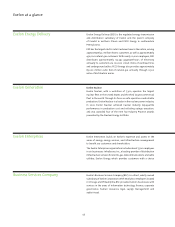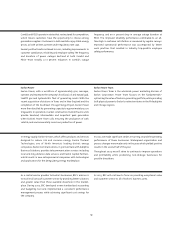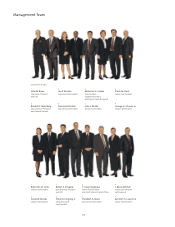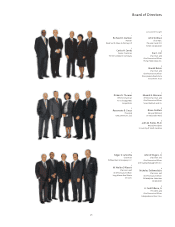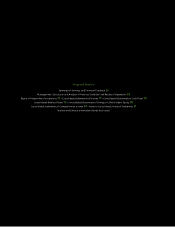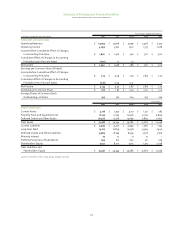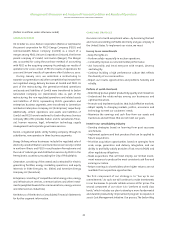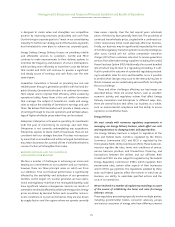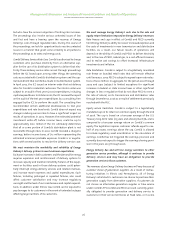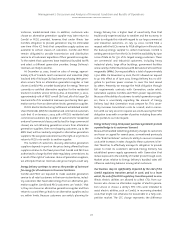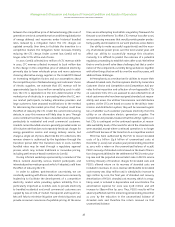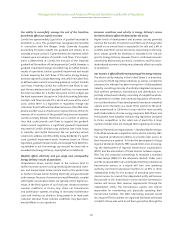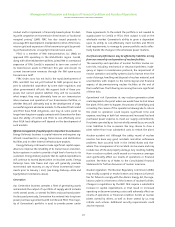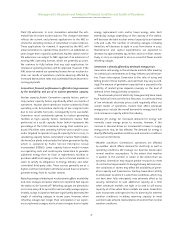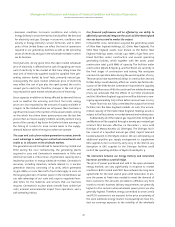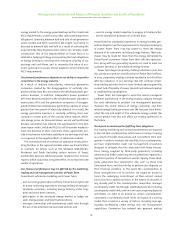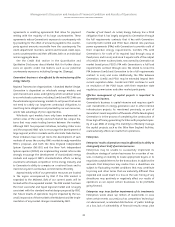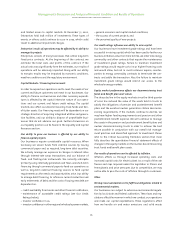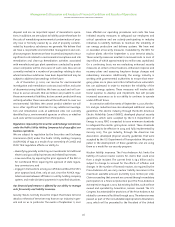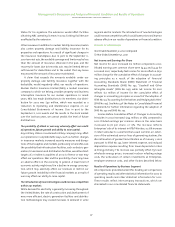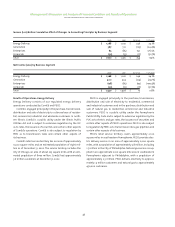ComEd 2002 Annual Report Download - page 30
Download and view the complete annual report
Please find page 30 of the 2002 ComEd annual report below. You can navigate through the pages in the report by either clicking on the pages listed below, or by using the keyword search tool below to find specific information within the annual report.
between the competitive price of delivered energy (the sum of
generation service at competitive prices and the regulated price
of energy delivery) and recoveries under historical bundled
rates, reduced by a mitigation factor. The CTC charges are
updated annually. Over time, to facilitate the transition to a
competitive market, the mitigation factor increases, thereby
reducing the CTC charge. Under current law, ComEd will no
longer collect CTCs at the end of 2006.
In 2001, ComEd collected $110 million of CTC revenue, while
in 2002, CTC revenue collected increased to $306 million due
to the change in the competitive price of delivered electricity,
primarily due to lower wholesale prices and more customers
choosing alternative energy suppliers or the ComEd PPO. Based
on increasing mitigation factors and our assumptions about
the competitive price of delivered energy and customers’choice
of electric suppliers, we estimate that CTC revenue will be
approximately $250 to $300 million annually by 2006. In addi-
tion, the CTC is dependent on the ICC’s determination of the
market price of electricity. In a proceeding before the ICC, vari-
ous market participants, including alternative providers and
large customers, have proposed modifications to the method
for determining the market price that, if accepted, could have
the effect of reducing the CTC.Under the current restructuring
statute, in 2007 this revenue will likely drop to zero. Through
2006,ComEd will continue to have a bundled service obligation,
particularly to residential and small commercial customers.
ComEd’s current bundled service is generally provided under an
all-inclusive rate that does not separately break out charges for
energy generation service and energy delivery service, but
charges a single set of prices. Much like the CTC collections, this
revenue stream is authorized by the legislature through the
transition period. After the transition ends in 2006, ComEd’s
bundled rates may be reset through a regulatory approval
process, which may include traditional or innovative pricing,
including performance-based incentives to ComEd.
During informal workshops sponsored by a member of the
Illinois General Assembly, various market participants and
interested parties made proposals which,if adopted,could have
the effect of reducing the CTC.
In order to address post-transition uncertainty, we are
constantly working with Illinois state and business community
leadership to facilitate the development of a competitive
electricity market while providing system reliability. This is
particularly important as ComEd’s costs to provide electricity
to bundled residential and small commercial customers are
capped by law at 110% of market. Transparent and liquid mar-
kets will help to minimize litigation over electricity prices and
provide consumers assurance of equitable pricing. At the same
time,we are attempting to establish a regulatory framework for
the post-2006 timeframe.To offset CTC revenue loss after 2006,
we are pursuing measures that would provide greater produc-
tivity,quality and innovation in our work practices across Exelon.
Our ability to make successful acquisition(s) and the recov-
ery of wholesale power prices over the next several years will
affect our ability to successfully manage this situation.
Currently, it is difficult to predict the outcome of a potential
regulatory proceeding to establish rates after 2006. We believe
that no one factor will solve these challenges,but that a combi-
nation of the components currently being worked on, together
with other things that we will do over the next four years, will
address these challenges.
In Pennsylvania,as a mechanism for utilities to recover their
allowed stranded costs, the Pennsylvania Electricity Generation
Customer Choice and Competition Act (Competition Act) pro-
vides for the imposition and collection of non-bypassable CTCs
on customers’ bills. CTCs are assessed to and collected from all
retail customers who have been assigned stranded cost respon-
sibility and access the utilities’ transmission and distribution
systems. As the CTCs are based on access to the utility’s trans-
mission and distribution system, they will be assessed regard-
less of whether such customer purchases electricity from the
utility or an alternative electric generation supplier. The
Competition Act provides,however,that the utility’s right to col-
lect CTCs is contingent on the continued operation, at reason-
able availability levels,of the assets for which the stranded costs
were awarded, except where continued operation is no longer
cost efficient because of the transition to a competitive market.
PECO has been authorized by the PUC to recover stranded
costs of $5.3 billion ($4.6 billion of unamortized costs at
December 31, 2002) over a twelve-year period ending December
31, 2010, with a return on the unamortized balance of 10.75%.
PECO’s recovery of stranded costs is based on the level of transi-
tion charges established in the settlement of PECO’s restructur-
ing case and the projected annual retail sales in PECO’s service
territory. Recovery of transition charges for stranded costs and
PECO’s allowed return on its recovery of stranded costs are
included in revenues. In 2002,revenue attributable to stranded
cost recovery was $850 million and is scheduled to increase to
$932 million by 2010, the final year of stranded cost recovery.
Amortization of PECO’s stranded cost recovery, which is a regu-
latory asset, is included in depreciation and amortization. The
amortization expense for 2002 was $308 million and will
increase to $879 million by 2010. Thus, PECO’s results will be
adversely affected over the remaining period ending December
31, 2010 by the reduction in the unamortized balance of
stranded costs and therefore the return received on that
unamortized balance.
Management’s Discussion and Analysis of Financial Condition and Results of Operations
exelon corporation and subsidiary companies
28


